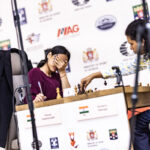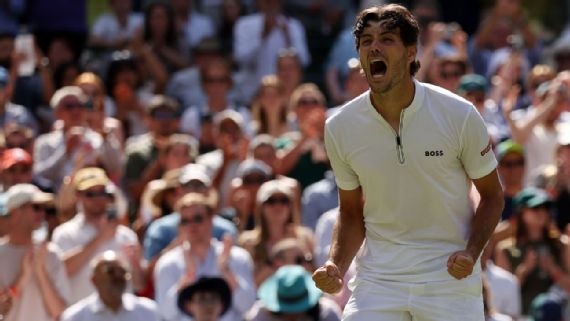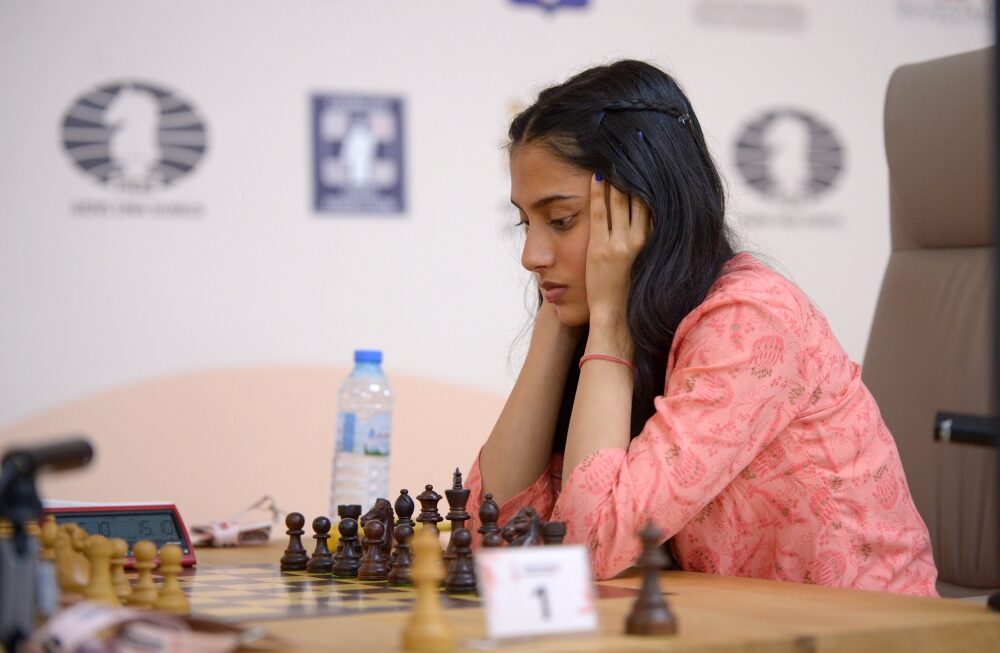Taylor Fritz Defeats Karen Khachanov to Reach Wimbledon 2025 Semifinals: Historic American Achievement
Fritz’s Resilient Victory Secures First Wimbledon Semifinal Berth
Taylor Fritz’s remarkable journey at Wimbledon 2025 reached new heights as he secured his first-ever semifinals appearance at the All England Club with a commanding 6-3, 6-4, 1-6, 7-6 (4) victory over Karen Khachanov. This historic achievement makes Fritz the first American man to reach the Wimbledon semifinals since John Isner accomplished the feat in 2018, marking a significant milestone for United States tennis.
The No. 5-seeded Fritz demonstrated exceptional mental fortitude throughout the match, overcoming a challenging third-set collapse and physical discomfort to secure his place among the tournament’s final four competitors. His victory sets up a highly anticipated semifinal encounter with two-time defending champion Carlos Alcaraz of Spain, presenting Fritz with the opportunity to advance to his first Wimbledon final.
Breaking Through Previous Quarterfinal Barriers
Fritz’s triumph over Khachanov carries additional significance given his previous struggles in major quarterfinals. Prior to this breakthrough performance, the American held a disappointing 1-4 record in Grand Slam quarterfinals, including two painful five-set losses at Wimbledon. These previous defeats had clearly weighed heavily on Fritz’s mind, as evidenced by his post-match comments expressing relief at avoiding another heartbreaking quarterfinal exit.
The psychological burden of past failures often creates additional pressure for elite athletes, particularly in tennis where mental strength plays a crucial role in championship matches. Fritz’s ability to overcome these demons while battling physical discomfort demonstrates the maturity and championship mindset that has been developing throughout his career.
Record-Breaking Grass Court Performance in 2025
Fritz’s path to the Wimbledon semifinals has been paved by an extraordinary grass-court season that has established new benchmarks for American tennis. His remarkable 13-1 record on grass courts during the 2025 season represents the most grass-court victories on the ATP Tour, surpassing all competitors in this specialized surface category.
This exceptional grass-court performance becomes even more impressive when placed in historical context. Fritz’s 13 grass-court wins mark the highest total achieved by any American man in a single season since the ATP Tour’s formation in 1990, highlighting the rarity and significance of his accomplishment.
The foundation of Fritz’s grass-court success was built through title victories at both Stuttgart and Eastbourne, tournaments that served as crucial preparation for Wimbledon. These championship runs provided Fritz with the confidence and match experience necessary to navigate the unique challenges presented by grass-court tennis.
Match Analysis: Overcoming Physical and Mental Challenges
Early Dominance and Strategic Execution
Fritz’s opening performance against Khachanov showcased the tactical improvements that have elevated his game to new levels. During the first two sets, he demonstrated exceptional serving prowess, winning 40 of 47 service points while never facing a break point opportunity. This statistical dominance reflected Fritz’s ability to dictate play through aggressive serving and strategic court positioning.
The American’s early success stemmed from his ability to maintain consistent pressure on Khachanov’s service games while protecting his own delivery with clinical efficiency. This approach effectively neutralized Khachanov’s powerful baseline game and established Fritz as the aggressor throughout the opening stages of the match.
Third Set Collapse and Medical Intervention
The dramatic shift in momentum during the third set presented Fritz with his greatest challenge of the tournament. Khachanov’s sudden resurgence, capturing eight of nine games, coincided with Fritz’s physical discomfort that necessitated a medical timeout. The sight of Fritz removing his right shoe and sock for foot retaping revealed the physical toll that extended grass-court play can exact on elite athletes.
During this medical intervention, Fritz’s serving velocity dropped significantly, with his fastest serve reaching only 117 mph compared to his previous maximum of 135 mph. This 18 mph reduction in serving speed clearly indicated the impact of his physical condition on his performance, providing Khachanov with the opportunity to seize control of the match.
Fourth Set Recovery and Tiebreak Mastery
Fritz’s recovery in the fourth set demonstrated the mental resilience that separates championship-caliber players from their peers. Despite falling behind 2-0 and appearing to struggle with fatigue, Fritz gradually regained his strength and tactical focus. His ability to generate three match points while leading 5-4 and 6-5 showed his determination to close out the victory.
The decisive tiebreak proved to be a showcase of Fritz’s improved mental game under pressure. After the score reached 4-all, Fritz claimed the final three points with the composure and shot-making ability that champions require in crucial moments. This clutch performance erased memories of previous tiebreak failures and demonstrated his growth as a competitor.
Historical Context and American Tennis Significance
Breaking the American Drought
Fritz’s semifinal achievement carries particular significance for American men’s tennis, which has struggled to produce consistent Grand Slam contenders in recent years. His success joins him with Frances Tiafoe and Ben Shelton as the only American men to reach multiple major semifinals in the current era, highlighting the emergence of a new generation of American tennis talent.
The broader impact of Fritz’s success extends beyond individual achievement to represent a potential renaissance in American men’s tennis. His breakthrough performance at Wimbledon, combined with the continued development of players like Shelton and Tiafoe, suggests that American tennis may be entering a new era of Grand Slam competitiveness.
Historical Wimbledon Perspectives
Fritz’s semifinal appearance occurs against the backdrop of significant historical trends at Wimbledon. The tournament has not produced a first-time major champion since Roger Federer’s breakthrough victory in 2003, creating a streak of 20 consecutive Wimbledons without a maiden Grand Slam champion. This represents the longest such streak in tournament history, emphasizing the difficulty of breaking through at the sport’s most prestigious event.
The American perspective on Wimbledon success has been particularly challenging, with Andy Roddick’s 2009 final appearance representing the last time an American man reached the championship match. Fritz’s current position provides him with the opportunity to end this 16-year drought and potentially claim America’s first Wimbledon title since 2000.
Technical Analysis: Fritz’s Serving Excellence
Power and Precision Statistics
Fritz’s serving performance throughout the tournament has been characterized by exceptional power and strategic placement. His 16 aces against Khachanov, combined with a top serving speed of 138 mph, demonstrate the technical improvements that have elevated his grass-court game to elite levels.
The significance of Fritz’s serving statistics extends beyond raw power to encompass strategic variety and situational effectiveness. His ability to maintain high first-serve percentages while generating significant pace has created a formidable combination that grass-court specialists require for sustained success.
Tactical Serving Adaptations
Fritz’s tactical approach to serving has evolved significantly throughout his career, with his 2025 grass-court season representing the culmination of these improvements. His ability to adjust serving strategies based on match situations, court conditions, and opponent tendencies has become a defining characteristic of his game.
The development of Fritz’s serving variety has been particularly evident in his ability to mix pace, placement, and spin effectively. This tactical sophistication has allowed him to maintain serving dominance even when facing elite returners like Khachanov, who possess the ability to neutralize power-based serving approaches.
Khachanov’s Performance and Historical Context
Ranking and Achievement Analysis
Karen Khachanov’s quarterfinal appearance represented a continuation of his consistent Grand Slam performances, though his defeat to Fritz highlighted ongoing challenges against top-ranked opponents. The Russian’s 0-11 record in Grand Slam matches against top-five opponents reveals a significant psychological and tactical barrier that has prevented breakthrough achievements.
Despite reaching two previous major semifinals, Khachanov’s inability to overcome elite opposition in crucial moments has become a defining characteristic of his career. His performance against Fritz demonstrated both his competitive capabilities and the limitations that have prevented him from achieving his full potential.
Technical Strengths and Weaknesses
Khachanov’s powerful baseline game and athletic ability have consistently enabled him to reach the later stages of major tournaments. His ability to generate pace from both wings and cover the court effectively makes him a formidable opponent for any player on the tour.
However, Khachanov’s tactical limitations against elite opponents have become increasingly apparent. His tendency to rely primarily on power over strategic variety has created predictable patterns that experienced players like Fritz can exploit during crucial moments.
Looking Ahead: Semifinal Showdown with Alcaraz
Match-Up Analysis
Fritz’s upcoming semifinal encounter with Carlos Alcaraz presents both tremendous opportunity and significant challenge. The two-time defending champion’s exceptional grass-court abilities and recent dominance at Wimbledon make him a formidable opponent for any challenger.
The tactical dynamics of this match-up will likely center on Fritz’s serving power against Alcaraz’s return capabilities and court coverage. Fritz’s ability to maintain first-serve percentages while generating consistent pressure will be crucial for creating opportunities against the Spanish champion.
Strategic Considerations
Fritz’s preparation for the Alcaraz encounter will need to focus on tactical variety and situational awareness. His previous meetings with the Spanish player have provided valuable insights into effective strategies, though Alcaraz’s continued development requires constant tactical adjustments.
The mental aspect of facing a defending champion will present additional challenges for Fritz. His ability to maintain the confident and aggressive approach that has characterized his grass-court season will be essential for competing effectively against such an accomplished opponent.
American Tennis Future and Tournament Implications
Broader Impact on American Tennis
Fritz’s semifinal achievement represents more than individual success; it symbolizes the potential for American tennis to reclaim its position among the sport’s elite nations. His breakthrough performance, combined with the continued development of other American players, suggests a promising future for United States tennis.
The inspiration provided by Fritz’s success will likely influence the next generation of American tennis players, demonstrating that Grand Slam success remains achievable for American competitors. This psychological impact extends beyond immediate results to encompass long-term developmental benefits for American tennis.
Tournament Historical Significance
Fritz’s semifinal appearance contributes to what could become a historically significant Wimbledon tournament. The potential for breakthrough achievements and the convergence of established champions with emerging challengers creates narrative possibilities that extend beyond individual matches.
The broader tournament context, including the performances of other American players and the overall competitive landscape, positions this Wimbledon as potentially pivotal for the future direction of men’s tennis. Fritz’s success represents one component of these larger competitive dynamics.
Conclusion: A Historic Achievement with Future Implications
Taylor Fritz’s victory over Karen Khachanov to reach the Wimbledon 2025 semifinals represents a watershed moment for American tennis and a personal triumph that validates years of dedicated improvement. His ability to overcome physical challenges, mental barriers, and tactical obstacles demonstrates the championship qualities that elite tennis demands.
The significance of Fritz’s achievement extends beyond individual accomplishment to encompass broader implications for American tennis and the sport’s competitive landscape. His semifinal appearance provides inspiration for future American players while establishing him as a legitimate contender for Grand Slam success.
As Fritz prepares for his semifinal encounter with Carlos Alcaraz, he carries not only his own aspirations but also the hopes of American tennis fans who have waited years for this level of Grand Slam success. Regardless of the semifinal outcome, Fritz’s quarterfinal victory represents a historic achievement that will be remembered as a pivotal moment in his career and American tennis history.
Match Progression Analysis
graph TD
A[Match Start] --> B[Fritz dominates early<br/>40/47 service points won]
B --> C[Set 1: Fritz 6-3<br/>Strong serving display]
C --> D[Set 2: Fritz 6-4<br/>Maintains pressure]
D --> E[Set 3: Khachanov 6-1<br/>Fritz struggles, medical timeout]
E --> F[Physical treatment<br/>Foot retaping required]
F --> G[Set 4: Competitive battle<br/>Fritz recovers strength]
G --> H[Multiple match points<br/>5-4, 6-5 opportunities]
H --> I[Tiebreak 7-4<br/>Fritz claims victory]
I --> J[Semifinals vs Alcaraz<br/>Historic American achievement]
style A fill:#e1f5fe
style I fill:#c8e6c9
style J fill:#fff3e0













